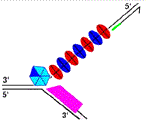Department of Chemistry

Mark A. Griep Publications
Document Type
Article
Date of this Version
2008
Abstract
The study of primases from model organisms such as Escherichia coli, phage T7 and phage T4 has demonstrated the essential nature of primase function, which is to generate de novo RNA polymers to prime DNA polymerase. However, little is known about the function of primases from other eubacteria. Their overall low primary sequence homology may result in functional differences. To help understand which primase functions were conserved, primase and its replication partner helicase from the pathogenic Gram-positive bacteria Staphylococcus aureus were compared in detail with that of E. coli primase and helicase. The conserved properties were to primer initiation and elongation and included slow kinetics, low fidelity, and poor sugar specificity. The significant differences included S. aureus primase having sixfold higher kinetic affinity for its template than E. coli primase under equivalent conditions. This naturally higher activity was balanced by its fourfold lower stimulation by its replication fork helicase compared with E. coli primase. The most significant difference between the two primases was that S. aureus helicase stimulation did not broaden the S. aureus primase initiation specificity, which has important biological implications.


Comments
Published in Molecular Microbiology 68:6 (2008), pp. 1570–1582; doi 10.1111/j.1365-2958.2008. 06255.x Copyright © 2008 Scott A. Koepsell, Marilynn A. Larson, Christopher A. Frey, Steven H. Hinrichs, and Mark A. Griep; journal compilation © 2008 Blackwell Publishing. Used by permission. http://www.blackwellpublishing.com/journals/mmi/